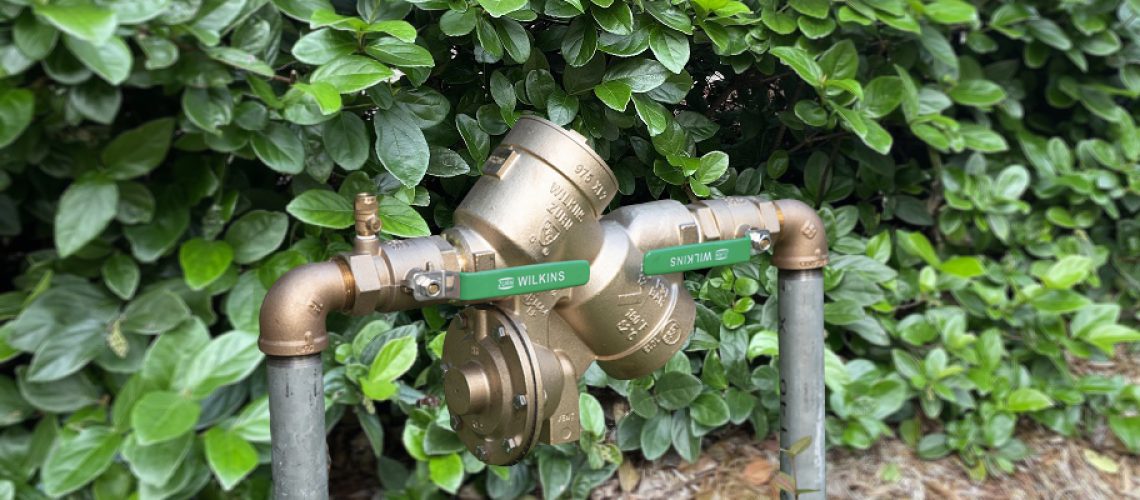You may have heard of water backflow, but what is a backflow preventer? Backflow preventers are essential to keeping the good water in and the bad water out. They protect the drinking water supply and help your city stay healthy.
What Is Backflow?
When we talk about backflow, we’re referring to water that “flows back” through water pipes. Many systems, like your plumbing and irrigation system, require water to run through the main supply line into the property. The water should only flow in one direction, but sometimes it doesn’t.
Fixing a backflow problem can be expensive and time-consuming. Remediating a backflow incident often takes several weeks and thousands of dollars.
Backflow can also be dangerous. If hazardous chemicals, pesticides, and other water contaminants seep into the public drinking water supply, it can cause severe health concerns. Many people have gotten seriously ill from backflow incidents in the past decade.
What Causes Backflow?
The primary cause of backflow is water pressure changes in the pipes. When the pressure changes and no longer pushes water down the pipes into your home, it can flow backward into the city water lines.
Pressure changes happen for various reasons. One common cause is when someone opens a fire hydrant. Another is when the main water lines encounter a break or blockage, potentially causing a backflow of contaminants like:
- Pesticides
- Fertilizers
- Chlorine
- Soap
- Antifreeze
A backflow could spell significant trouble for you, your family, and your entire neighborhood. Fortunately, there are backflow preventers to avoid this crisis.
What Is a Backflow Preventer?
What is a backflow preventer? Backflow preventers are devices that only allow water to flow one way: into your home’s central system lines. As the name implies, a backflow preventer prevents backflow.
Backflow preventers come in several different types, depending on their specific uses. For example, irrigation systems don’t use the same backflow preventers as fire sprinkler systems. These are the most common assembly types:
- Pressure Vacuum Breaker (PVB)
- Double Check Valve (DCV)
- Reduced Pressure Zone (RPZ)
Pressure Vacuum Breakers (PVBs)
PVBs have the most straightforward design and don’t cost as much as other backflow preventers. A trained professional can install them quickly, and it doesn’t take much to maintain or repair them. You’ll most likely see these assemblies on lawn irrigation systems.
Double Check Valves (DCVs)
You’ll want a DCV to prevent backflow if you have a fire sprinkler system. DCVs are more complex than PVBs and include upstream and downstream shutoff valves, two check valves, and several test cocks. With this heavy-duty design, DCVs are perfect for fire safety systems.
Double check valve assemblies to ensure a building’s fire protection system works correctly. However, DCVs do have one flaw. They might not prevent backflow if water-borne debris gets in the way or the valves fail to close.
Reduced Pressure Zones (RPZs)
RPZs are the most reliable and intricate backflow preventers. They include everything a double-check valve has and more, utilizing hydraulics for a practically failsafe. This backflow prevention device works best for internal water systems, such as fire protection and plumbing.
How Do Backflow Preventers Work?
So, how do backflow preventers work? They work like a one-way door for water to enter your property’s pipe systems without flowing back. Backflow preventers minimize water pressure changes so that backflows don’t occur.
An assembly with two check valves regulates the pressure within the piping system. Backflow preventers keep the pressure between the valves lower than the incoming water pressure, ensuring the water flows in and not back. If either valve leaks, a relief valve opens and expels the water.
If you have a reduced pressure zone assembly, you’ll want to install it away from areas prone to water damage. RPZs deal with higher pressure than other backflow preventers, meaning they’ll spew much more water if the check valves fail and the relief valve opens. You should also install proper drainage for the water discharge.
Do You Need a Backflow Preventer in Your Home or Business?
The short answer is yes – every home and business needs a backflow preventer. These devices allow water to enter your internal pipe system without sending contaminants back into the city’s water supply. Get professional backflow prevention testing and repair services if you don’t know whether you have a properly functioning backflow
Get Expert Plumbing Services Today!
The next question after “what is a backflow preventer?” is usually “how do I keep my water supply safe?” At Southwest Florida Service & Supply, we have the answers. Contact us at (239) 657-2429 to get expert backflow installation, maintenance, and repair.

